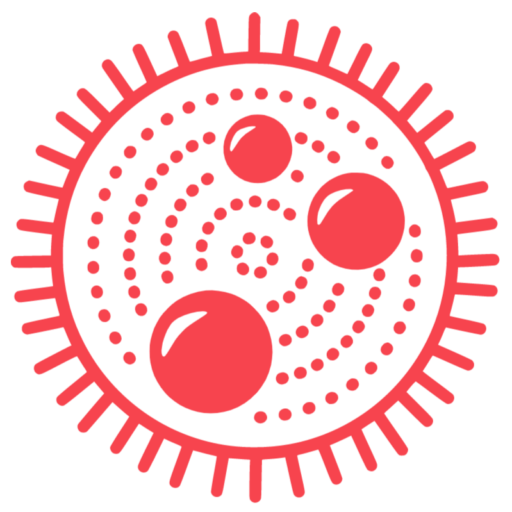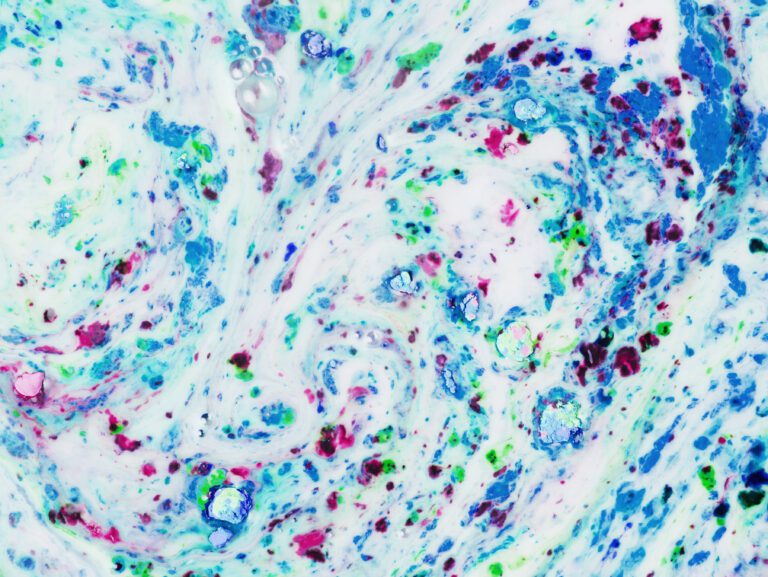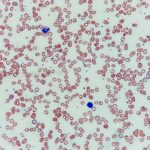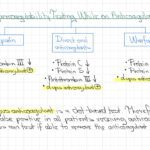
Providing care for patients with blood disorders is an art! Hematology is a highly clinical specialty where patients can develop multiple organ and system abnormalities presenting with diverse clinical features. The starting point is a thorough assessment with history taking and physical examination (H&P). Complementary testing can include blood tests, smear reviews, urine analysis, imaging, bone marrow examination, flow cytometry, and many other specialized tests. Even though testing in hematology can become incredibly specialized (such as genetic testing or other fancy tests), do not overlook the relevance of a good history and physical exam. In this post, we will focus on the medical history and physical examination in hematology. We will discuss more about complementary testing in future posts.
A misdiagnosis may not arise solely from misinterpreting a patient’s presentation, but rather from basing our diagnostic hypotheses on inaccurate or incomplete information obtained from our H&Ps.
History and Physical Examination
Obtaining an accurate and detailed history and physical examination is a key aspect in the evaluation of patients in hematology. It is important to develop an organized and structured method that can be used as a “template” for most evaluations that would allow one to acquire information accurately and efficiently.
Demographic information
Although this part is usually already obtained at the time of our assessments, it is crucial to acknowledge the patient’s age, gender at birth, sexual orientation, and cultural background, among others. Obtaining correct demographic information can help us understand our patients’ backgrounds and be sensitive to understanding them holistically and with cultural and inclusive sensitivity.
Chief Complaint
The chief complaint is the main symptom or reason a patient seeks medical attention. Understanding the chief complaint can help us focus the assessment, assess the urgency of the situation, and provide tailored care to our patients. The chief complaint can be used to design the visit and focus the history and physical examination to identify key information that can help us build our differential diagnosis. Sometimes the chief complaint a patient describes may not be the main symptom we as providers may be more worried about. However, addressing the patient’s chief complaint is essential as it will make them feel better and understood.
History of Present Illness (HPI)
The HPI describes the current condition that our patient is suffering. Acquiring organized and structured data can be extremely helpful in understanding our patient’s conditions. There are different styles and ways to perform an HPI. However, following a chronologic order in which we identify events from the first episode and move into the evolution of the symptoms can provide a better understanding of the natural history of the condition being evaluated. Using a general mnemonic can be quite helpful during the assessment of HPI. There are many mnemonics available. One of the most popular ones is “OLD CARTS” which stands for:
O – Onset: When did the symptoms start? Is this the first such episode? Gradual or rapid onset of symptoms?
L – Localization: In which body part?
D – Duration: How long did the symptoms last? Are the symptoms currently present?
C – Characteristics: How does the symptom feel like? Is the pain felt as a burning, sharp, dull sensation? Does it come and go?
A – Alleviating or exacerbating factors: What makes the symptom better or worse? What do you think may have caused this symptom?
R – Radiation: Does the symptom travel anywhere?
T – Timing: Does it come and go? How long does the pain last when present?
S – Severity: On a scale of 1-10, how bad is this symptom? Is the fatigue affecting your daily activities?
As a rule of thumb, it is recommended to start with open-ended questions letting the patient describe their history, and then ask follow-up questions to clarify or obtain more relevant information about the symptoms. Even though we may be jumping to objective data, reviewing previous health records, recent office or urgent care visits, recent emergency visits or admission, and others relevant to the presentation may be considered when understanding the chronology of the problem.
Common Complaints in Hematology
- Fatigue or generalized weakness: Few of the most common symptoms in medicine that can be related to hematologic and non-hematologic conditions. Fatigue that affects daily activities is concerning and asking our patients about their ability to take care of themselves, napping during the day, exhaustion at the end of their day, and other characteristics can help identify its severity. Fatigue can occur in patients with iron deficiency even in the absence of anemia.
- Weight loss: It is a frequent symptom seen in many serious conditions such as malignancy. Our history and examination can be helpful in the identification of the cause.
- Fever: Although the cause usually is infection or inflammatory conditions, fever can also be seen in many hematologic conditions including aggressive lymphomas or leukemias, myelodysplastic syndromes, myelofibrosis, and even in severe hemolytic anemias and pernicious anemia. Nightly fevers can be more worrisome for lymphoproliferative disorders but not exclusively as many other conditions such as tuberculosis can be the culprits.
- Night sweats: Night sweats can also occur similarly to fever. Drenching night sweats are a classic finding in patients with lymphoma and other malignancies.
- Pallor: Seen in patients with anemias in particular.
- Jaundice: Can be related to disorders in the hepatobiliary system such as obstructions by tumors or hemolysis (destruction of red blood cells).
- Bruising: Patients may present with bruising on the skin that can be related to disorders of hemostasis such as thrombocytopenia, coagulation factor deficiencies, disseminated intravascular coagulation, and many others.
- Petechiae: Patients can also report seeing small red dots in the skin called petechiae. We will describe more in the physical examination section below.
- Bleeding: It can be the presenting symptom for many conditions including thrombocytopenia, coagulation disorders, anticoagulation use, etc. Mucocutaneous bleeding (nosebleeds, gum bleeding, hematuria, gastrointestinal bleeding, urinary bleeding, and heavy menstrual bleeding) can occur in disorders of primary hemostasis (platelet or von Willebrand factor disorders). In contrast, deep bleeding such as intramuscular, intraabdominal, intracranial, or intraarticular can be seen in disorders of secondary hemostasis or coagulation (related to coagulation factor deficiencies or inhibitors).
- Enlarged lymph nodes: Can be described by patients as lumps usually in the cervical, axillary, or inguinal areas. Lymphadenopathy in malignancy and hematologic disorders may or may not be painful.
- Dark or red urine: This could represent the presence of blood or blood components such as hemoglobinuria in patients with intravascular hemolysis, myoglobinuria, or porphyrinuria.
What are the famous B symptoms? It is the combination of three symptoms defined as fevers, drenching night sweats, and loss of more than 10 percent of body weight over 6 months. B symptoms are classically assessed in many hematologic disorders, and are used in the staging and prognostication of lymphomas.
It is important to remember that symptoms can be secondary to non-hematologic disorders. For example, lymphadenopathy can be seen in patients with malignancy but there are many other causes including infection, inflammatory conditions, rheumatologic conditions, and others. Patients with anemia could have other complications and develop dyspnea, palpitations, and signs of fluid overload such as leg edema o congestive heart failure from chronic anemia. This is due to a compensatory increase in plasma volume that the body attempts to maintain volemia and oxygen supply to vital organs. There are other symptoms seen in hematology that can occur in particular conditions.
Women’s Health
Importantly, history-taking should include assessment of reproductive health in women including obstetric and gynecologic histories. Importantly, heavy menstrual bleeding is commonly seen in hematology. Normal menstrual bleeding can vary in women. However, any change that a patient reports to their usual bleeding pattern should be evaluated. Some women may have always had heavy menstrual bleeding that they could consider “normal” as well. To assess the extent of blood loss during menses, we can estimate heavy bleeding when the following situations are present:
- Change of pads/tampons needed at <3 hour intervals
- More than 21 pads/tampons used per cycle
- Need to change pads/tampons during the night
- Having clots (usually more than 1 inch in diameter)
- >3 menstrual heavy bleeding days or >7 total bleeding days
An objective measurement used in research is the loss of more than 80 mL of blood per period. However, objective measurement in clinical practice may be difficult. Menorrhagia or excessive menstrual bleeding can be secondary to many gynecologic and obstetric conditions. However, it can also be a sign of a primary hematologic disorder such as von Willebrand disease and other bleeding disorders.
Review of Systems (ROS)
The review of systems should always be addressed in all patient encounters to identify other possible symptoms that we may have not discussed or identified yet during our patient interview. Building a structured and thorough assessment is also recommended to help us identify relevant information to develop our differential diagnosis.
Medical History
Explore any relevant medical conditions and comorbidities and remember that many of them can affect the hematologic function. For example, chronic kidney disease can cause anemia. Inflammatory conditions can be associated with anemia of inflammation. Liver disease can affect many of the blood cells and other substances in the blood including proteins, coagulation factors, and others. Hematology is a highly clinical discipline and connecting all the dots in the clinical picture is imperative.
Surgical History
Previous surgeries are hemostatic challenges for patients. If a patient has undergone surgery without bleeding complications in the past and develops new bleeding tendencies, this information can help us understand a possible acquired bleeding disorder. The type of surgery speaks of the bleeding risk as well, particularly intraabdominal, intrathoracic, and intracranial procedures that carry a higher risk of bleeding. Transplantation of solid organs and bone marrow can also affect hematopoietic function. Immunosuppressant medications used with transplanted organs can be associated with blood disorders such as cytopenias as well.
Family History
Investigating the family history is crucial for understanding the inheritance and risk of certain blood disorders. A family history of anemia (sickle cell disease, thalassemia, etc.), bleeding disorders (such as hemophilia), clotting disorders, and malignancies can help us understand our patient’s conditions better. Usually, the most relevant information is to obtain data from first-degree relatives. However, any family history should be obtained and evaluated. Inheritance patterns are important. Here is a table with some of the common hematologic conditions in classical hematology with their inheritance pattern:
| Condition | Inheritance Pattern | Comments |
|---|---|---|
| Hemophilia | X-linked recessive | Hemophilia A and B are inherited in an X-linked recessive manner. Affected individuals typically inherit the mutated gene from their mother. Males are more commonly affected, while females are carriers (rarely can also develop hemophilia). |
| Sickle Cell Disease | Autosomal recessive | Sickle cell disease is inherited in an autosomal recessive pattern. Individuals must inherit two copies of the mutated gene (one from each parent) to develop the disease. Carriers (heterozygotes) are usually asymptomatic. |
| Thalassemia | Autosomal recessive | Thalassemia is inherited in an autosomal recessive manner. Individuals must inherit two copies of the mutated gene (one from each parent) to develop the disease. Carriers may exhibit mild symptoms or be asymptomatic. |
| Von Willebrand Disease | Autosomal dominant | Von Willebrand disease can be inherited in an autosomal dominant manner, though there are also autosomal recessive and X-linked recessive forms. In the autosomal dominant form, a single copy of the mutated gene is sufficient to cause the disease. Presents in males and females (can be helpful to distinguish hemophilia that occurs predominantly in men). |
| Hereditary Spherocytosis | Autosomal dominant | Hereditary spherocytosis is usually inherited in an autosomal dominant pattern. A single copy of the mutated gene is sufficient to cause the disease. However, autosomal recessive inheritance is also possible in some cases. |
| G6PD Deficiency | X-linked recessive | Glucose-6-phosphate dehydrogenase (G6PD) deficiency is inherited in an X-linked recessive pattern. Males are more commonly affected, while females can be carriers or exhibit symptoms depending on X-chromosome inactivation. |
Social History
Assess factors that may influence hematologic health including socioeconomic challenges, substance use, dietary habits (e.g., vegetarianism), occupational exposures (e.g., chemical or radiation exposure), travel history, and sexual practices. Social support and living conditions are relevant. Many of our patients face incredible challenges that go beyond their medical conditions and hurt their outcomes and quality of life.
Medications and Allergies
Medication reconciliation and review are extremely important in hematology. Hematology consults are usually related to a side effect or the use of certain medications. Androgen use is a common culprit of polycythemia. The sodium-glucose cotransporter-2 (SGLT2) inhibitors used in diabetes and other cardiovascular conditions can be associated with polycythemia as well. Many medications can cause hematologic adverse events and become an important part of our assessment. Besides the assessment of the medication list, inquiring about herbs and other over-the-counter medications can provide important information. Assess allergies to medications to avoid the use of potentially harmful drugs. Finally, although not officially “medications,” this is a good section to consider inquiring about vaccinations that can be associated with certain hematologic conditions such as venous thromboembolism or immune thrombocytopenia.
Physical Examination in Hematology
A detailed physical examination should be performed on all patients. Furthermore, when suspecting hematologic disorders, there are several areas of interest to assess. Let’s review some of the important physical exam findings seen in hematologic syndromes.
Pallor: Commonly seen in anemias. Our patients or those who are close to them may notice a change in the coloration of the skin that can help identify a change.


Jaundice: As previously mentioned, yellowish coloration of the skin and eyes is related to hemolysis and liver disease. Better examined under daylight instead of fluorescent lights that can mask the yellow color.

Cyanosis: Blue coloration of the skin and mucosas. Can be seen in hypoxia and other disorders including methemoglobinemia, and sulfhemoglobin.

Petechiae: Small, round (1-2 mm) red to brown lesions in areas of high venous pressure such as the lower extremities. Typically seen in platelet disorders such as thrombocytopenia and vasculitis.
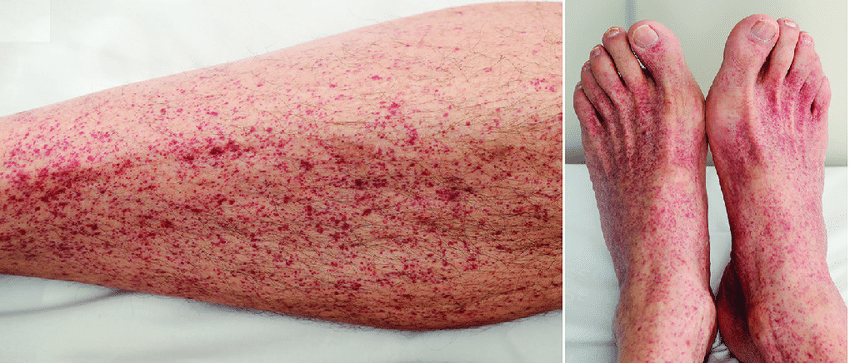
Ecchymoses: Bruising noted in the skin usually of blue, purple, red, or yellow-green coloration depending on its age. Usually seen in bleeding disorders.

Leg ulcers: Open ulcers or scars can be seen in the internal or external malleoli areas (ankles) of patients with sickle cell disease.
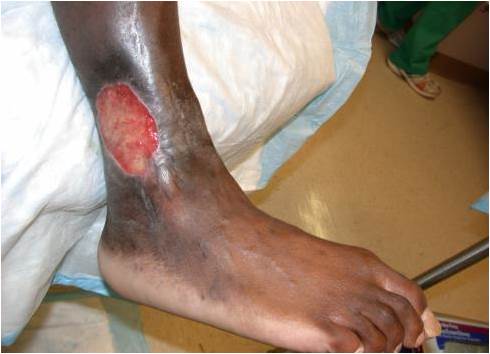
Nail deformities: Koilonychia is the flattening or concave rather than convex shape of the nail that can rarely be seen in iron deficiency anemia.
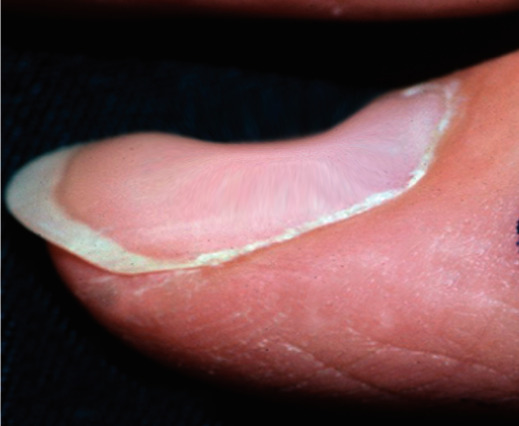
Smooth tongue: Seen in iron deficiency and pernicious anemia.

Gum hypertrophy: This can be seen in infiltrative processes such as leukemias and lymphomas.
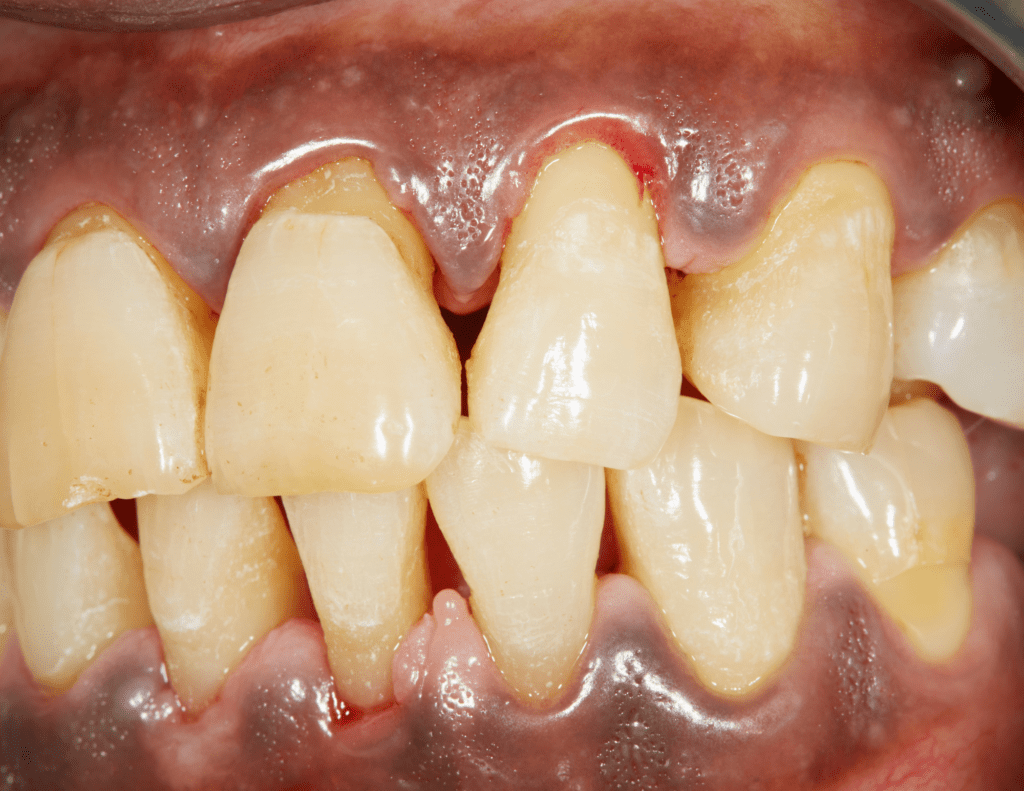
Joint deformities: Can be seen in patients with hemophilia due to intraarticular hemorrhages.
Neuropathy: Sensory neuropathy can be associated with several hematologic disorders including plasma cell dyscrasias, amyloidosis, hemochromatosis, and other rare conditions such as POEMS syndrome (polyneuropathy, organomegaly, endocrinopathy, monoclonal gammopathy, and skin changes). Vibration and proprioception abnormalities can be seen in vitamin B12 deficiency.
Examination of the lymphatic system, spleen, and liver is commonly performed in hematology. Understanding a correct technique can help us be more accurate in detecting abnormalities when present. Here is a short description of how to perform such exams in practice.
Lymph Node Examination
Spleen Examination
The spleen is not palpable in normal conditions. However, when splenomegaly occurs, it can be palpated on the left side of the abdomen under the costal margins. It is difficult to measure the spleen but when possible, it can be measured from the costal margin. Splenomegaly occurs in hematologic malignancies, infections, hemolysis, and other reactive processes.
Liver Examination
Careful examination is important to recognize important clinical clues that can be valuable in the assessment of our patients. Assessing our patient’s performance status with tools such as the Karnofsky Performance Score or the Eastern Cooperative Oncology Group (ECOG) can help us determine our patient’s function and possible tolerance to medications. Physical exam findings in hematology are interesting and becoming familiar with them can help us become more proficient and better clinicians when treating our patients.
Thank you very much for reading! We hope this information was useful.
